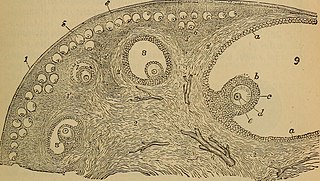
The ovary is a gonad in the female reproductive system that produces ova. When an ovum is released, this travels through the fallopian tube/oviduct into the uterus. There is an ovary found on the left and the right side of the body. The ovaries also secrete hormones that play a role in the menstrual cycle and fertility. The ovary progresses through many stages beginning in the prenatal period through menopause. It is also an endocrine gland because of the various hormones that it secretes.

Rats are various medium-sized, long-tailed rodents. Species of rats are found throughout the order Rodentia, but stereotypical rats are found in the genus Rattus. Other rat genera include Neotoma, Bandicota and Dipodomys.

The black rat, also known as the roof rat, ship rat, or house rat, is a common long-tailed rodent of the stereotypical rat genus Rattus, in the subfamily Murinae. It likely originated in the Indian subcontinent, but is now found worldwide.

The brown rat, also known as the common rat, street rat, sewer rat, wharf rat, Hanover rat, Norway rat and Norwegian rat, is a widespread species of common rat. One of the largest muroids, it is a brown or grey rodent with a body length of up to 28 cm (11 in) long, and a tail slightly shorter than that. It weighs between 140 and 500 g. Thought to have originated in northern China and neighbouring areas, this rodent has now spread to all continents except Antarctica, and is the dominant rat in Europe and much of North America. With rare exceptions, the brown rat lives wherever humans live, particularly in urban areas.

The nutria or coypu is a large, herbivorous, semiaquatic rodent from South America. Classified for a long time as the only member of the family Myocastoridae, Myocastor is now included within Echimyidae, the family of the spiny rats. The nutria lives in burrows alongside stretches of water and feeds on river plant stems. Originally native to subtropical and temperate South America, it has since been introduced to North America, Europe and Asia, primarily by fur farmers. Although it is still hunted and trapped for its fur in some regions, its destructive burrowing and feeding habits often bring it into conflict with humans, and it is considered an invasive species in the United States. Nutria also transmit various diseases to humans and animals, mainly through water contamination.

The Muroidea are a large superfamily of rodents, including mice, rats, voles, hamsters, lemmings, gerbils, and many other relatives. Although the Muroidea originated in Eurasia, they occupy a vast variety of habitats on every continent except Antarctica. Some authorities have placed all members of this group into a single family, Muridae, due to difficulties in determining how the subfamilies are related to one another. Many of the families within the Muroidea superfamily have more variations between the families than between the different clades. A possible explanation for the variations in rodents is because of the location of these rodents; these changes could have been due to radiation or the overall environment they migrated to or originated in. The following taxonomy is based on recent well-supported molecular phylogenies.

Pest control is the regulation or management of a species defined as a pest; such as any animal, plant or fungus that impacts adversely on human activities or environment. The human response depends on the importance of the damage done and will range from tolerance, through deterrence and management, to attempts to completely eradicate the pest. Pest control measures may be performed as part of an integrated pest management strategy.

Rodenticides are chemicals made and sold for the purpose of killing rodents. While commonly referred to as "rat poison", rodenticides are also used to kill mice, woodchucks, chipmunks, porcupines, nutria, beavers, and voles. Despite the crucial roles that rodents play in nature, there are times when they need to be controlled.

A rat-catcher is a person who kills or captures rats as a professional form of pest control. Keeping the rat population under control was practiced in Europe to prevent the spread of diseases, most notoriously the Black Death, and to prevent damage to food supplies. In modern developed countries, such a professional is otherwise known as a pest control operative or pest exterminator.

The Old World rats and mice, part of the subfamily Murinae in the family Muridae, comprise at least 519 species. Members of this subfamily are called murines. In terms of species richness, this subfamily is larger than all mammal families except the Cricetidae and Muridae, and is larger than all mammal orders except the bats and the remainder of the rodents.

The lesser bandicoot rat, Sindhi rice rat, Bengal rat or Indian mole-rat is a giant rat of Southern Asia, not related to the true bandicoots which are marsupials. They can be up to 40 cm long, are considered a pest in the cereal crops and gardens of India and Sri Lanka, and emit piglike grunts when attacking. The name bandicoot is derived from the Telugu language word pandikokku, which translates loosely to "pig-rat". Like the better known rats in the genus Rattus, bandicoot rats are members of the family Muridae. Their fur is dark or (rarely) pale brown dorsally, occasionally blackish, and light to dark grey ventrally. The head-body length is around 250 mm, and the uniformly dark tail is shorter than the head-body length.
"Behavioral sink" is a term invented by ethologist John B. Calhoun to describe a collapse in behavior that can result from overpopulation. The term and concept derive from a series of over-population experiments Calhoun conducted on Norway rats between 1958 and 1962. In the experiments, Calhoun and his researchers created a series of "rat utopias" – enclosed spaces where rats were given unlimited access to food and water, enabling unfettered population growth. Calhoun coined the term "behavioral sink" in a February 1, 1962, Scientific American article titled "Population Density and Social Pathology" on the rat experiment. He would later perform similar experiments on mice, from 1968 to 1972.
Wildlife contraceptives are contraceptives used to regulate the fertility of wild animals. They are used to control population growth of certain wild animals.
Rat-bite fever (RBF) is an acute, febrile human illness caused by bacteria transmitted by rodents, in most cases, which is passed from rodent to human by the rodent's urine or mucous secretions. Alternative names for rat-bite fever include streptobacillary fever, streptobacillosis, spirillary fever, bogger, and epidemic arthritic erythema. It is a rare disease spread by infected rodents and caused by two specific types of bacteria:
- Streptobacillus moniliformis, the only reported bacteria that causes RBF in North America
- Spirillum minus, common in Asia. Most cases occur in Japan, but specific strains of the disease are present in the United States, Europe, Australia, and Africa.

The ecological restoration of islands, or island restoration, is the application of the principles of ecological restoration to islands and island groups. Islands, due to their isolation, are home to many of the world's endemic species, as well as important breeding grounds for seabirds and some marine mammals. Their ecosystems are also very vulnerable to human disturbance and particularly to introduced species, due to their small size. Island groups, such as New Zealand and Hawaii, have undergone substantial extinctions and losses of habitat. Since the 1950s several organisations and government agencies around the world have worked to restore islands to their original states; New Zealand has used them to hold natural populations of species that would otherwise be unable to survive in the wild. The principal components of island restoration are the removal of introduced species and the reintroduction of native species.

Rodents are mammals of the order Rodentia, which are characterized by a single pair of continuously growing incisors in each of the upper and lower jaws. About 40% of all mammal species are rodents. They are native to all major land masses except for New Zealand, Antarctica, and several oceanic islands, though they have subsequently been introduced to most of these land masses by human activity.

Rats in New York City are widespread, as they are in many densely populated areas. They are considered a cultural symbol of the city. For a long time, the number of rats in New York City was unknown, and a common urban legend declared there were up to five times as many rats as people. However, a 2023 study estimates that there are approximately 3 million rats in New York, which is close to a third of New York's human population.

4-Vinylcyclohexene dioxide (VCD) is an organic compound that contains two epoxide functional groups. It is industrially used as a crosslinking agent for the production of epoxy resins. It is a colourless liquid. It is an intermediate for synthesis of organic compounds.
SenesTech, Inc. is an agricultural biotechnology life-sciences company, specializing in fertility management as a form of pest control. The company's primary product, ContraPest is designed to make brown and black rats infertile. SenesTech is headquartered in Phoenix, Arizona.

Ovarian stem cells are oocytes formed in ovarian follicle before birth in female mammals. They do not form post-natally, and are depleted throughout reproductive life. In humans it is estimated that 500,000–1,000,000 primordial follicles are present at birth, decreasing rapidly with age until roughly age 51 when ovulation stops, resulting in menopause. The origin of these oocytes remains under discussion. The publication of a study in 2004 proposing germ cell renewal in adult mice sparked a debate on the possibility of stem cells in the postnatal ovary. An increasing number of studies suggest that stem cells exist within the mammalian ovary and can be manipulated in vitro to produce oocytes, but whether such ovarian stem cells have the potential to differentiate into oocytes remains uncertain.
















